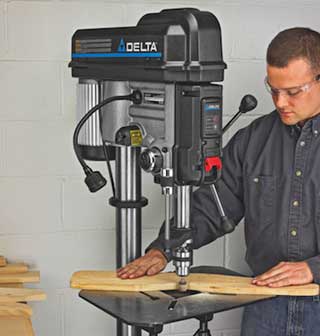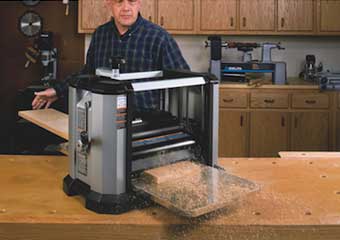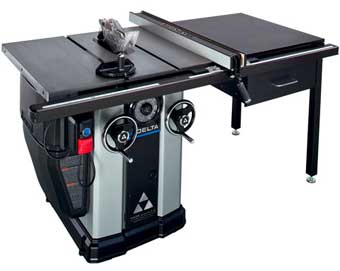
Six years ago, Black & Decker purchased the Delta and Porter-Cable brands from Pentair. More recently, Stanley and Black & Decker merged in early November of last year to create the new Stanley Black & Decker – a company with an estimated net worth of $8.4 billion. It encompasses The Stanley Works, Bostitch, Black & Decker, DeWalt, Delta and Porter-Cable brands, among several others.
I’ve been curious about how the subsidiary companies within this umbrella are adjusting to the new corporate structure and what opportunities it provides to their development of woodworking products. Last week, I had the chance to speak with Bill Harman, director of marketing for Delta, who helped bring me up to speed on some of their latest tools. He also provided a glimpse into how Delta’s new parent company is helping it meet the needs of woodworkers these days, as well as the challenges Delta faces to build high quality tools in today’s global marketplace.
Principally, Bill says Delta is benefiting from last November’s merger. “Stanley Black & Decker provides an infusion of resources for us, which is allowing us to do some different and exciting things…Behind the scenes, I can tell you we are going to continue to move woodworking forward from the Delta and Porter-Cable brands in the months and years to come.”
One area Stanley Black & Decker is pursuing vigorously is patenting. Bill reported that, in a recent edition of the Wall Street Journal, Black & Decker was rated as the second highest U.S.-based company in terms of patent applications. He feels it testifies to the company’s commitment to retain its unique tool feature sets as long as possible. “It (patenting) allows us to sustain a premium price point and not have to chase costs with our competition to a point that we’re hampering quality…We want to deliver the best quality day in and day out.”
Arriving at those unique “feature sets” is a process that takes Bill and his team out into the field and into woodworking shops to conduct extensive research. “We shadow end users so we can stand back, watch and better understand how they use their tools. We want to develop application solutions instead of just another product on the market.”
In this regard, Bill directed me to a feature on Delta’s new 18-900L 18-in. Laser Drill Press, developed specifically to address a typical hassle with most drill presses: changing speeds. Delta’s field studies confirmed that many of us either never change a drill press’s speed, do it as infrequently as possible or try to compensate for a different speed by plunging more slowly or quickly. The new drill press includes a patent-pending Auto-Tensioning Belt Drive System that uses an idler pulley to make speed changes more convenient. It’s also designed to maintain constant belt tension, which prevents slipping and eliminates the need for manual adjustment. The new drill press comes with an oversized table that tips left and right as well as tilts forward up to 48° for setting compound drilling angles. Here’s a feature that should come in very handy for woodworking.
A new 13-in. Portable Thickness Planer (model 22-590) also includes several end user-inspired features. One is an Infinite Micro-Adjust Depth Stop. Bill says that, while the cutterhead on other typical benchtop planers can be locked at only a handful of material thicknesses, Delta learned that woodworkers are more concerned about uniformity from one board to the next—not necessarily hitting a perfect 3/4- or 1/2-in. standard. So, the new Delta planer enables the machine to be set and locked to any material thickness between 1/4 and 1-1/4 in. as well as to a number of pre-set detents. It also has a full-width material removal gauge so that thickness evaluations are made not just from a narrow area in the middle of the cutterhead — the usual gauge style — but from wherever you feed a workpiece into the machine, and on any width stock. Delta hopes the new gauge will also help extend the life of the planer knives by encouraging use of the left and right ends of the knives as well as the center area.
Aside from learning about these new products and their enhancements, I asked Bill to comment on Delta’s current position regarding building more “Made in America” tools. It’s a factor Delta is proud to display on the front of the latest Unisaw, re-designed and launched a few years ago. I’ve witnessed firsthand the saws being assembled at the company’s Jackson, Tennessee, manufacturing facility.
Bill was quick to point out that in addition to the Unisaw, a number of other Delta machines are made in the United States, including radial arm saws, shapers and line-boring machines. A new series of saw blades as well as Delta’s Biesemeyer fences also are manufactured here. However, Delta has learned through ongoing focus group research that an American-made tool is not the only factor considered important by many end users. Woodworkers also want feature sets that will deliver the “real world” performance they expect from the tool, and this is key to their buying decision. So is a competitive price.
Harman maintains that Delta will seek the best sources to develop and build its new machinery, in order to deliver high quality and the application-driven features we request. Whether that means the company makes the machine internally or sources it elsewhere is a decision made on a “case by case basis,” and in a fiscally responsible manner. On this last point, I appreciated Bill’s candor and honesty. There’s no debating the fact that the 21st century is a global marketplace.
Long story short, it appears Delta is forging ahead with a stronger base of resources from its new Stanley Black & Decker parent. Their continued focus on meeting the needs of tool users is an important goal, as its always been, and of course we woodworkers benefit directly from those efforts. In today’s challenging economic times, creating new and improved machinery at prices we are willing to pay is no small undertaking for any manufacturer – Delta included. But, according to Bill Harman, Delta is prepared for the challenge. I know I’ll look forward to seeing what lies ahead from one of woodworking’s industry leaders.









